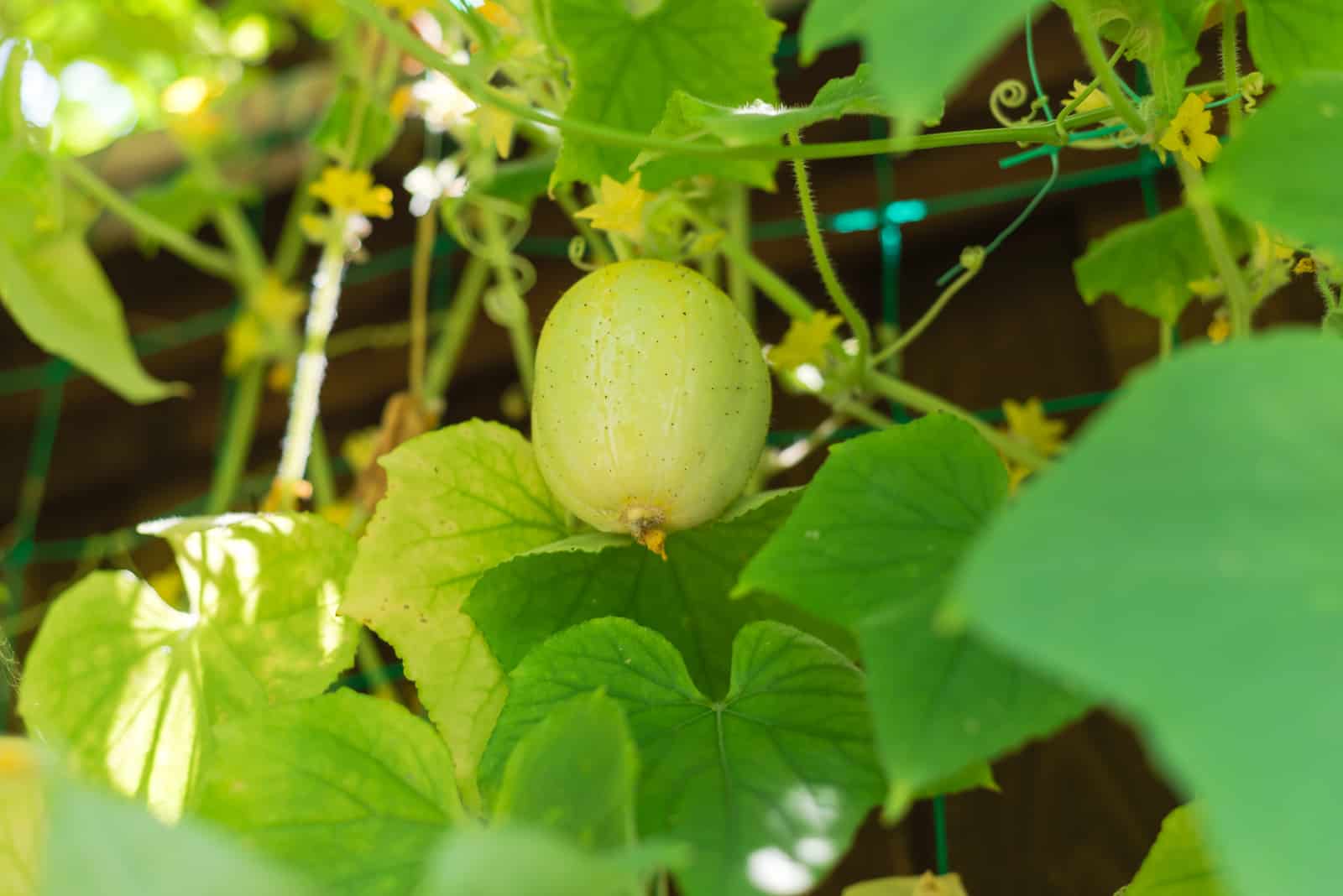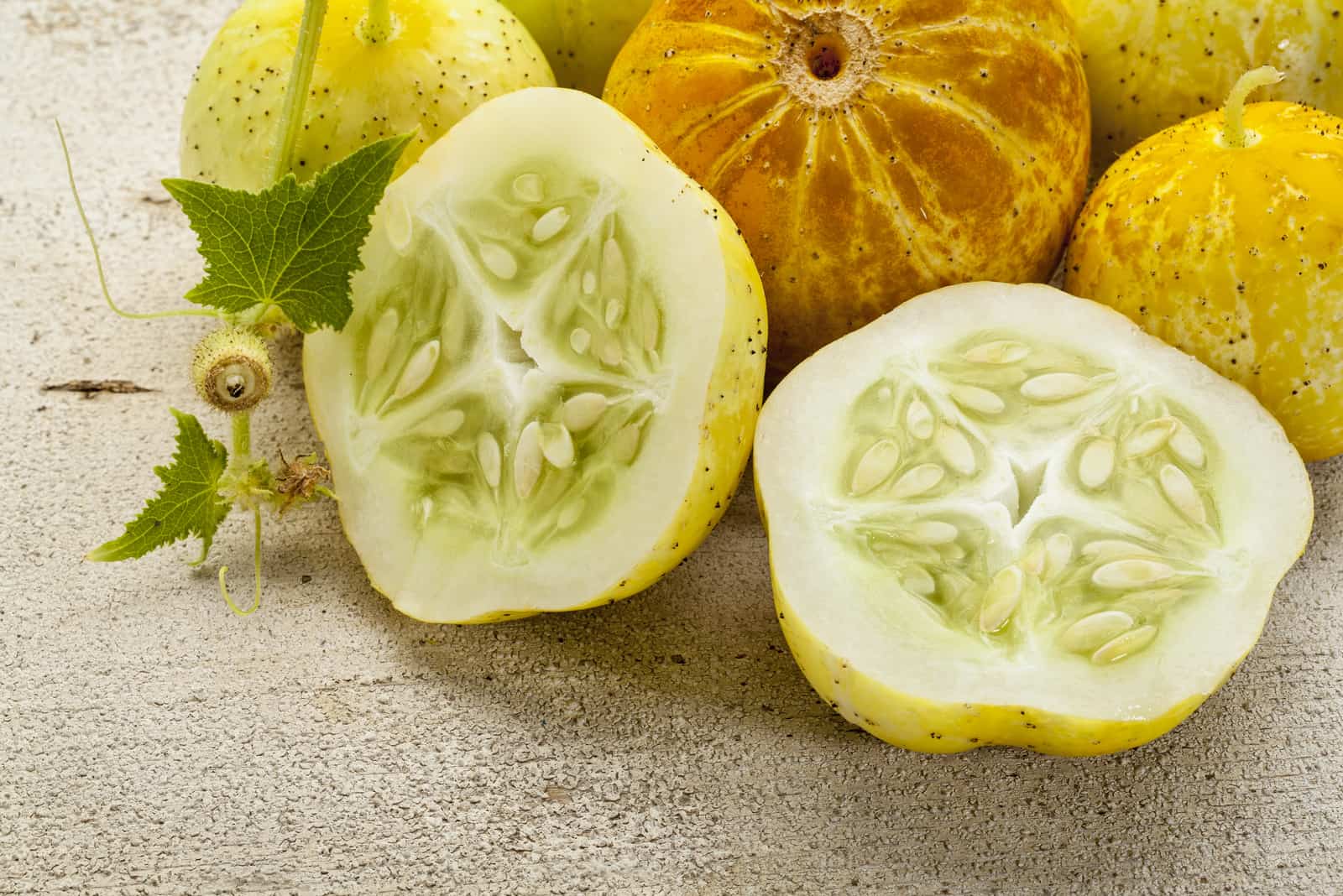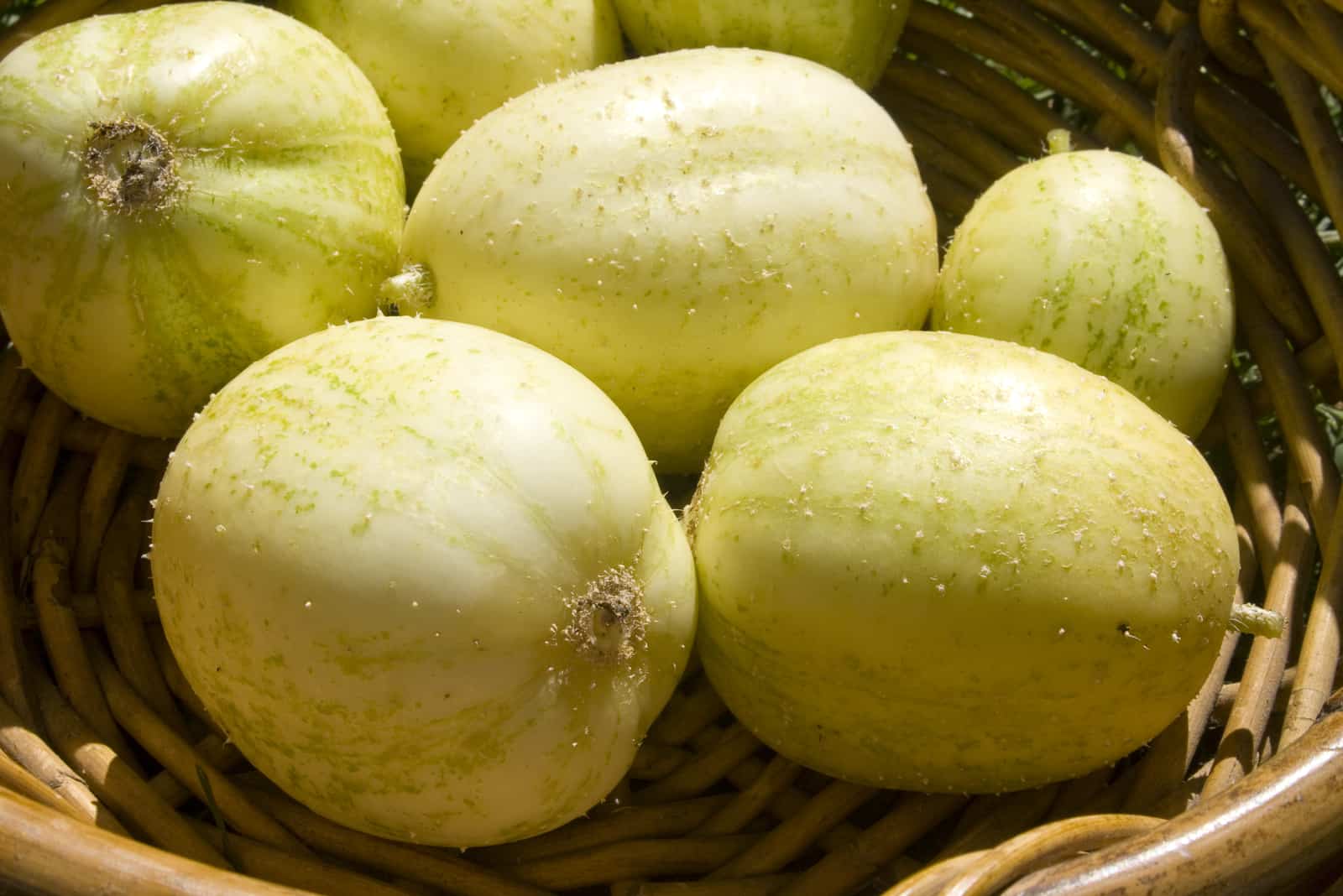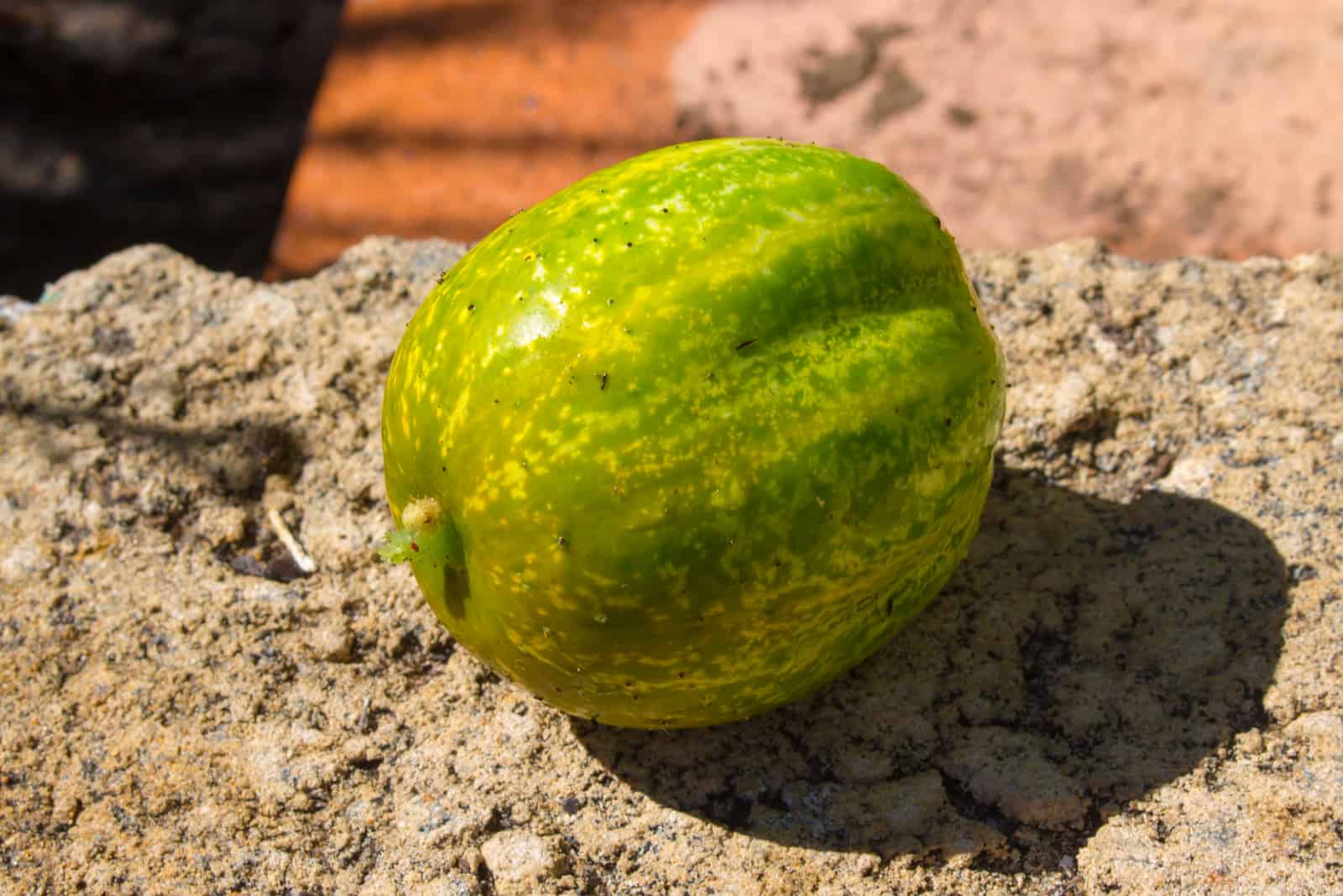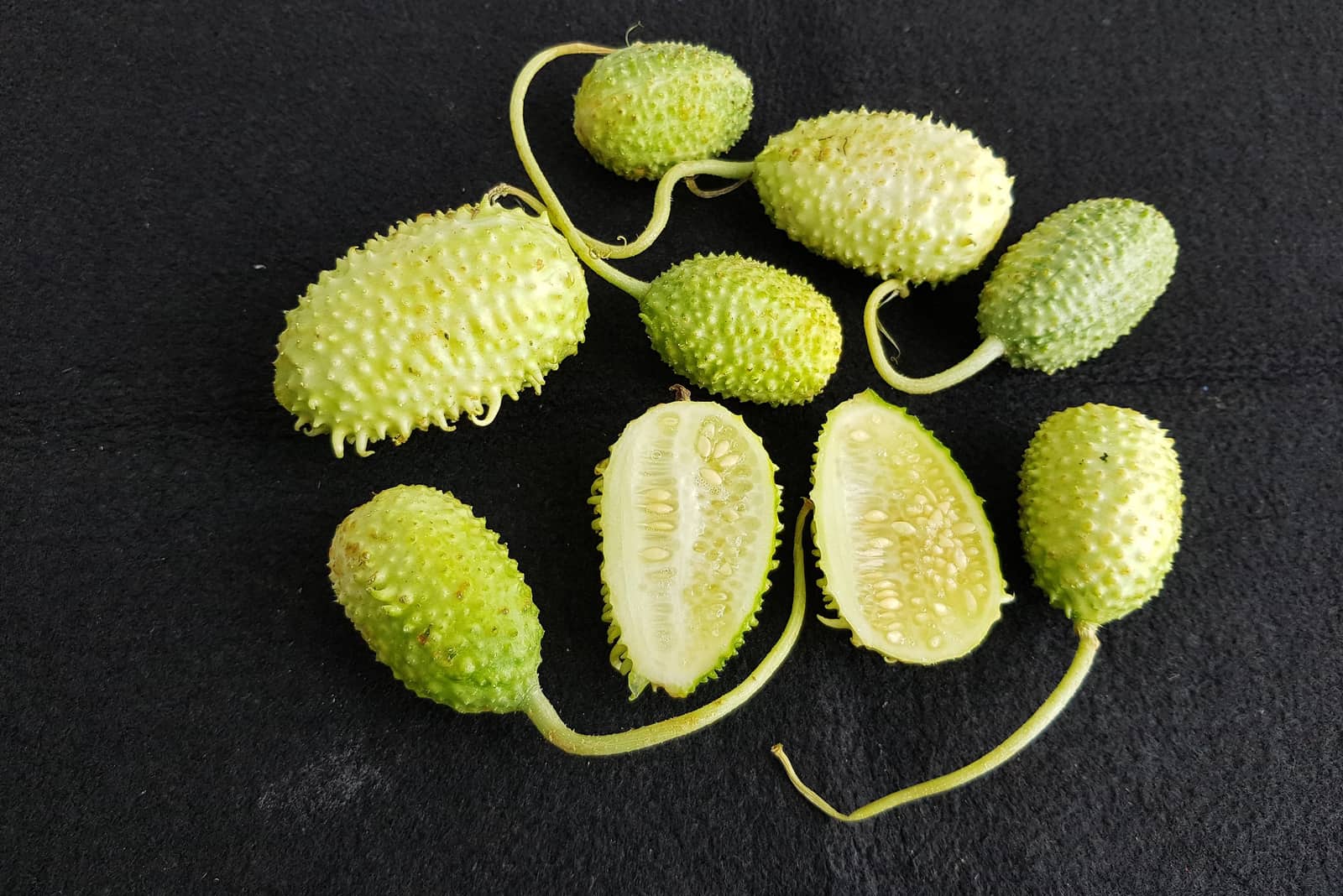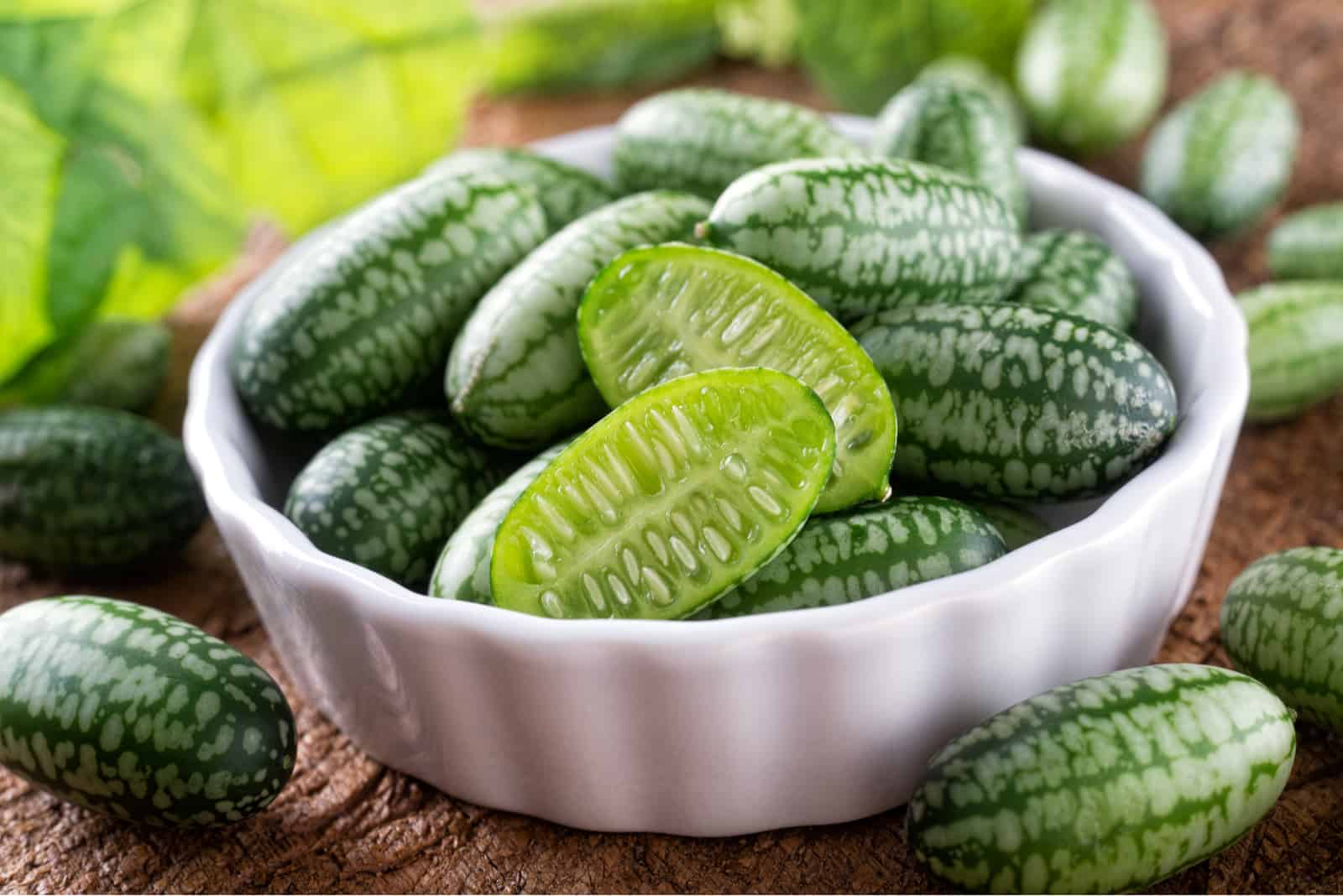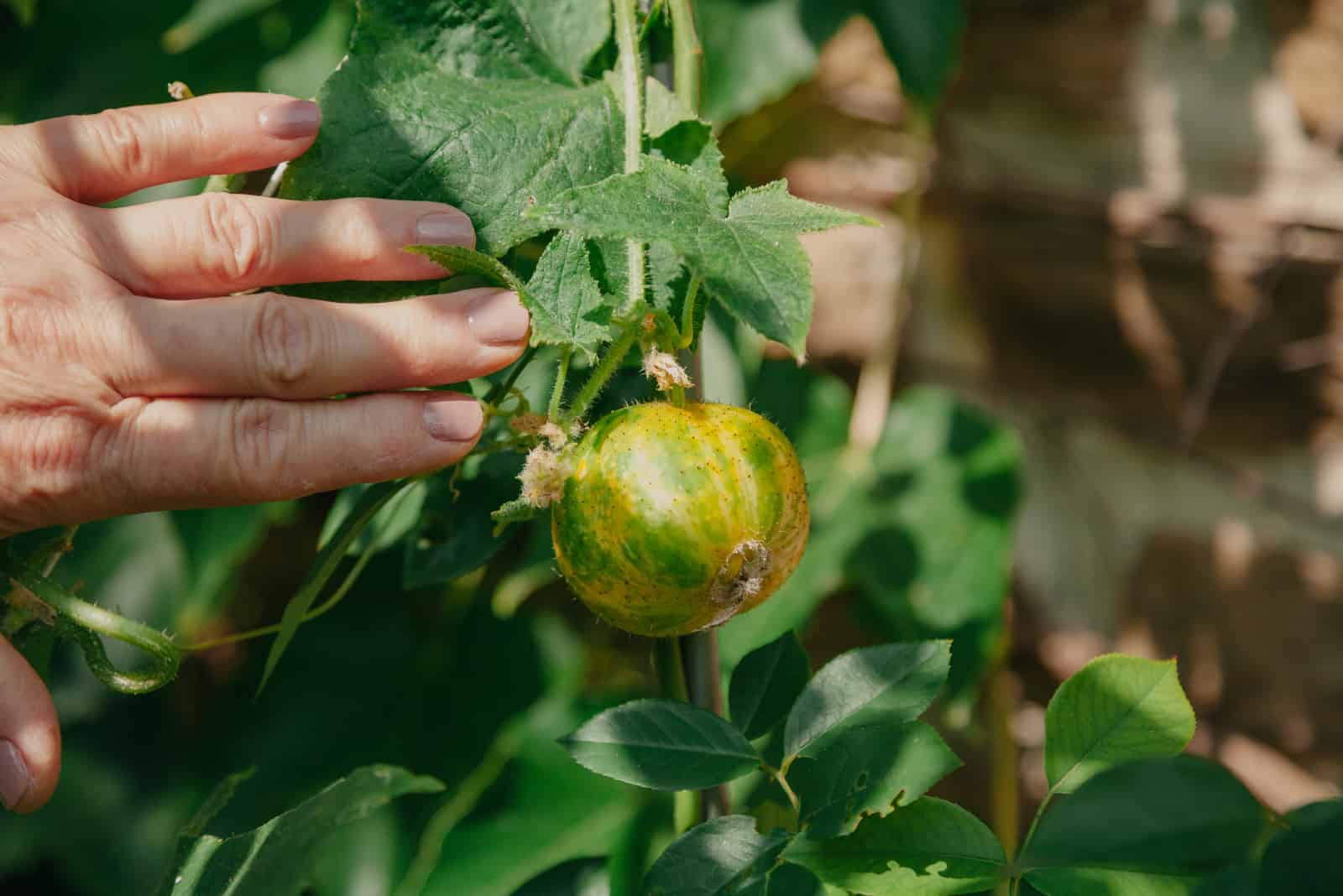A round cucumber is something we aren’t used to seeing every day. But, even though they’re not your typical heirloom variety, you can still grow them and surprise your friends and family with an interesting salad.
Before we continue this article, here’s some info about cucumbers:
[table id=80 /]
Now that you know some basic things about cucumbers, it is time to learn more about round cucumbers.
They may have an unusual shape, but you can still enjoy this vegetable and use it in your cooking.
You can read about our five favorite round cucumber varieties in this article and learn their most prominent features. We’ll also bring you their care guides and the different ways to use them if you decide you need to have this unusual vegetable in your garden.
Let’s begin!
5 Round Cucumber Varieties
Cucumbers are generally undemanding, and this section brings you the care guides for some amazing round cucumbers.
In addition to the overall care, it is important to know when and how to start and care for cucumber seedlings, so you can get the best of each variety.
We bring you both the essential and more advanced information about these cucumbers, and we’ll even bring you the different ways of using them, which will help you decide which variety is the right one for you
1. Lemon Cucumber
It is no secret why they are called Lemon cucumbers. However, even though these cucumbers resemble large lemons, their taste is entirely different.
Before we get into any further details, here are the general specifics about this cucumber variety:
[table id=81 /]
Lemon cucumbers are quite small, but don’t let their size fool you! They have the same taste as regular cucumbers, only milder, and once you try them, you won’t be able to resist adding some color to your salads.
Appearance And Usage
The Lemon cucumber resembles a lemon or a tennis ball in both color and size, but the flavor couldn’t be any more different. The light yellow color might lead us to expect a citrusy flavor, but once you try these yellow cucumbers, you’ll see that they barely differ from the green variety.
The vines are 6-8 feet (1.8-2.4 m) tall and produce yellow flowers in midsummer, late summer, and early fall, meaning there will be plenty of yellow cucumbers in your salads.
You can use these crunchy cucumbers in the same way that you use regular cucumbers, and if you want to pickle this variety, you should harvest the fruits when they are no longer than 1.5 inches (3.8 cm).
Light Requirements
This cucumber variety requires full sun in order to produce a high yield and good fruit.
If you cannot find a sunlit place for this plant, you can always grow it in a greenhouse under grow lights.
Water And Humidity
Lemon cucumbers need regular watering and moist soil, and you can achieve this by giving your plant 1 inch (2.5 cm) of water throughout the week.
Irregular watering will stress the plant, which will produce bitter fruit in return.
You need to water this cucumber a few times a week during hot summer days to avoid drying the soil.
And finally, always water the plant at the soil level, as too much moisture on the foliage may lead to powdery mildew.
However, if you grow these cucumbers in container gardens, you will need to water them more often, so you should check the soil every day.
They don’t require any particular humidity levels and will thrive in moderately humid environments.
Temperature
These cucumbers are perfect for cooler climates and thrive in temperatures between 60-90 °F (15-32 °C).
However, keep in mind that the soil temperature should be at least 55 °F (13 °C) when planting these cucumber seeds.
Soil And Fertilizer
This variety of yellow cucumbers prefers mildly acidic soil with a pH level between 6.5-7.0. They are heavy feeders, so you’ll have to mix additional nutrients in your ground soil or your regular potting mix.
Adding compost with phosphorus enriches the soil with nutrients and helps with drainage, an equally important soil feature.
Lastly, you don’t have to fertilize this variety to have a good harvest, and adding manure or compost before planting provides all the nutrients it needs.
However, you should consider mulching your plants because doing so retains moisture and the correct temperature of the soil, so you won’t have to worry about it too much later.
Transplantation
The best time to transplant this cucumber is in mid-late spring or early summer. If you don’t have enough space to plant the cucumbers 3-7 feet (0.9-2.1 m) apart, you should stake them using trellises that allow you to plant these cukes 1.5-2 feet (45-60 cm) apart.
Finally, lemon cucumbers are fast growers, and it takes about 60 days after planting for them to reach maturity
2. Apple Crystal Cucumber
When shopping in cucumber shops, it is not uncommon to see a surprise seed packet of an unknown cucumber variety.
An Apple cucumber might just be what you get, and if you’re unsure what it actually is and how to grow it, we’re here to help you.
Here’s the basic info on an Apple crystal cucumber:
[table id=82 /]
The Apple crystal is another type of cucumber that will add color to your dishes. Again, it tastes nothing like the fruit with which it shares its name, so you don’t have to change your old recipes for this veggie.
We also must mention this: don’t ignore the yellowing of cucumber leaves of any variety. The most common causes are over- or under-watering, improper light exposure, pest attacks, and infections. All these issues may reduce the yield and even kill your plants if they aren’t treated.
Appearance And Usage
Do you remember those Granny Smith apples that you adored as a child? Well, they’re precisely what this cucumber looks like.
Its pale green color and brown freckles make it almost indistinguishable from a Granny Smith, but its prickly skin gives it away. Once you slice this cucumber, you’ll notice the difference immediately, as its insides are filled with cucumber seeds.
This slicer variety is great eaten fresh, and the crunchy, juicy fruit has a sweet flavor that will add freshness to any dish.
You may not find this variety in your around-the-corner grocery store, but you can host an unforgettable lunch for your family if you grow it yourself.
Light Requirements
This cucumber plant needs at least 6 hours of sunlight every day to produce the best fruit. If your region gets extremely hot in the summertime, you should shield this plant or grow it in partial shade, as direct sunlight can cause damage to this plant.
Water And Humidity
When you’re planting this variety, the soil needs to be soaking, but after you plant it, you should refrain from watering it until you notice new growth.
After that, water the plant regularly, especially in hot climates where you might need to water it 2-3 times a week.
Irregular watering leads to a bitter taste, and no one likes bitter-tasting cucumbers!
It thrives in environments with low to moderate humidity levels, as a high humidity may lead to diseases such as powdery mildew.
Temperature
The lowest temperature that this variety can handle is 60 °F (15 °C); anything lower than that will stunt the plant’s growth and the production of its fruit.
At this temperature, it takes about two weeks for the seeds to germinate, but if the temperature reaches 85 °F (29 °C), it only takes three days.
Soil And Fertilizer
Just like most cucumbers, this variety also likes a slightly acidic medium with a pH of no lower than 6.5. The soil needs to be rich in nutrients and organic matter and well-draining to avoid root rot.
We always mulch the soil when growing cucumbers since mulching helps maintain the correct temperature and moisture level, so we don’t have to monitor it every day.
One thing this variety doesn’t like is too much fertilizer. If you enrich the soil with compost or organic fertilizer before planting, there should be no need for additional fertilization.
Transplantation
This variety is more productive in the late summer when the days are shorter, so you should plant the seeds in the late spring and transplant them when the third set of leaves appears.
It takes about 60-70 days until maturation, and if you’re careful about plant spacing (which should be around 3 feet apart (90 cm), you will harvest a good yield in September.
Also, if you have grown your cucumbers in pots and you want to transplant them outside, you should harden them first so they can acclimate to the outside conditions.
Take the pots outside for about a week before the actual transplant, so the plants don’t suffer transplant shock.
3. Mandurian Round Cucumber
Have you ever sown watermelons in your vegetable garden, only to find that they are not watermelons at all but rather a strange variety of cucumbers?
It happened to us, and even though our feelings were divided at that very moment, we decided to continue growing this unusual cucumber variety.
Here is the basic information on the Mandurian round cucumber:
[table id=83 /]
This small carosello variety is the perfect vegetable: it has very few seeds and a crunchy texture that means you won’t be able to resist this slicer variety.
But if you want to know more about its appearance, features, usage, and requirements, you should read the section below.
Appearance And Usage
The Mandurian carosello has variegated skin, where the light background is streaked with dark green lines, which is why we confused it with a watermelon.
However, once it matures, its skin is covered with fuzz, and it feels like you’re holding a giant peach in your arms.
It is burpless, meaning it has no or reduced levels of cucurbitacin, the substance that makes the cucumber bitter.
This makes it perfect for eating raw or adding it to salads and sauces.
Light Requirements
If you want to have a crisp cucumber, you need to expose it to at least 6-8 hours of sunlight every day.
However, too much direct sunlight may hurt the plant, so you might want to shelter it during the hot summer months.
Water And Humidity
One thing that all cucumbers have in common is that they are not drought-tolerant plants; they need plenty of water to produce sweet-tasting fruit.
You should water this variety at least once a week, and if the weather is scorching, water it 2-3 times per week.
This cucumber plant prefers moderate humidity levels, but it would benefit from higher humidity so it can be grown with other varieties of greenhouse vegetables or on its own.
Temperature
The Mandurian round cucumber is a heat-tolerant plant that can produce fruit even when the temperature gets to around 110 °F (43 °C).
That said, it prefers warm weather, and temperatures at around 85 °F (29 °C) guarantee the best fruit production.
Soil And Fertilizer
This variety can tolerate a wide range of soils with pH levels of between 5.6-7.0.
However, it needs to be planted in fertile, well-draining soil. Also, you should add compost to the ground soil before planting it to enrich it with organic material.
Later fertilization is not necessary, and if you continue feeding this variety, it will only lead to fertilizer burn on the foliage and fruit drop.
Transplantation
You should start growing this vegetable approximately one month before moving it outdoors.
It takes around 65-80 days until it reaches maturity, and before the plant is established, you should give it plenty of water, not letting the soil dry.
4. Maroon Cucumber
The Maroon cucumber is definitely a unique vegetable that everyone will ask you about. Its looks are very unusual, but the taste is almost the same as that of a common cucumber.
Here are the general specifics:
[table id=84 /]
This vegetable might look like a medieval weapon, but they are completely harmless and will even make a great addition to a refreshing salad.
Appearance And Usage
The Maroon cucumber is also known as the maxise, burr gherkin, West Indian gherkin, West Indian gourd, and cackrey. Its vine can grow up to 10 feet (3 m) long, and it produces oblong fruit, covered with spines.
The flesh is usually pale green, and because of its mild cucumber taste, you can use it to make salads, in dishes, or you can pickle them.
Also, if you ever come across a plant with gherkin in its name, it is highly likely that it is a cultivar of the Maroon cucumber.
Light Requirements
This vegetable requires full sun to produce the best fruit.
If you grow it in shaded areas, your yield will not be as good, and the size and taste of the fruit might decrease, so you might want to get some plant lights if you’re growing this cucumber variety indoors.
Water And Humidity
Maroon cucumbers require regular water and the soil always needs to be moist.
However, be careful not to overwater this plant as it can lead to root rot and other fungal infections. But, if the summers are scorching, you might need to water it more often, especially if the humidity levels are low.
Speaking of humidity, it prefers lower to moderate humidity levels.
Temperature
This variety needs warm weather to set fruit; it is very delicate, and it cannot survive cold weather.
The perfect temperatures are between 60-90 °F (15-32 °C), and if the temperatures are lower than 60 °F (15 °C), this plant might even refuse to germinate.
Soil And Fertilizer
The Maroon cucumber can grow in slightly acidic, neutral, and somewhat alkaline substrates, although it prefers a mildly acidic medium. It can grow in sandy, loam, and clay soils as long as they are well-draining and aerated.
You should fertilize this vegetable with phosphorus fertilizer because nitrogen fertilizer will only support the vegetative growth of the plant (vines and leaves), and there will be no energy left for fruit production.
Use a slow-release fertilizer before planting a Maroon cucumber, and you won’t have to worry about further fertilization.
Transplantation
If you’re starting this cucumber plant outdoors, you should plant it after the last frost. However, if you’re planting the seeds in containers you keep inside, you should plant the seeds approximately 4 weeks before the last expected frost date.
Transplant the new plants after all danger of frost has passed and keep the soil moist.
The plant reaches maturity in 60-65 days and, after the fruit has ripened, you should harvest it regularly to encourage further fruit production.
5. Cucamelon
The last round cucumber variety we will discuss is the Cucamelon. Just like the Mandurian round cucumbers, cucamelons aren’t really cucumbers. However, their taste resembles the taste of cucumbers, and we simply had to add them to our list.
First, the basic info:
[table id=85 /]
These small watermelon cucumbers are a great snack, and if you don’t like their taste, you can always give them to your tortoises.
The health benefits of cucamelons never cease to amaze us as they are rich in nutrients such as vitamins C, E, and K, potassium, meaning they are good for your vision, skin, brain’s proper function, and more.
Appearance And Usage
Other common names for cucamelons are the Mexican sour gherkin, sandita, and a mouse melon. Their vines are usually 1 foot (30 cm) tall and 10 feet (3 m) wide.
They bear fruit that looks like baby watermelons due to their coloring but they taste nothing like it. Cucamelon has the taste of a bitter cucumber, and it can be eaten alone or added to salads to give it some authenticity.
It is an acquired taste, so don’t worry if you don’t like it at first.
Light Requirements
Cucamelons are no different from all the abovementioned varieties. They need full sun to flourish, but they can also grow in partial shade, although the yield will not be as high.
However, if the temperatures are r
Water And Humidity
eally high, they can even benefit from some shade.
This plant loves moisture, and it should be getting 1 inch (2.5 cm) of water every week.
The best source of water is rain; however, if you live in a region with little rainfall, you can always water the cucamelons yourself.
Water them at the soil level. Installing a drip irrigation system would be best for you and your plants if you can find a way to do so
Cucamelons prefer high humidity levels, so if you live in regions with an arid climate, the best option is to grow these plants in a greenhouse, where you can control the humidity level.
Temperature
This plant loves the warmth and will not even start to germinate if the soil temperature is below 60 °F (15 °C).
However, after germination, their preferred temperature is 78 °F (26 °C).
Soil And Fertilizer
Cucamelon can tolerate any kind of soil as long as it is well-draining, but it prefers mediums with a mildly acidic pH level.
We always add compost which improves the drainage and keeps some moisture, which is necessary for the plant’s growth.
Mulching your cucamelons is an excellent idea as it helps to maintain the moisture levels and keep the temperature at the same level.
Also, you don’t have to fertilize cucamelons if you have added compost to the soil. Still, if you want a bigger harvest, you can add a starter fertilizer when they are about a month old and again in midsummer to encourage fruit production.
Transplantation
To reduce the risk of transplant shock, you should first harden your plants by gradually introducing them to external light conditions.
You can transplant the cucamelons after a week of hardening as long as the night temperatures aren’t too cold.
We always transplant cucamelons a week or two after the last frost date!
The general rule is to enrich the soil with manure or compost before transplanting cucamelons.
Water the plant thoroughly after the transplant and, if you don’t have enough space, you can always stake them with trellises.
Q & A Corner
Now that you know some of our favorite round cucumber varieties, it is time to answer some questions about them.
They are not Armenian cucumbers, but they are still enjoyable, healthy, and have many benefits.
Why are these cucumbers round and not long?
Some cucumber varieties occur round-shaped in nature, whereas others usually become rounded or distorted due to poor pollination, irregular watering, or over-fertilization.
Cucumbers that are poorly pollinated bulge near the stem but don’t grow, resulting in swelled, chubby cucumbers.
Also, you need to water your cucumbers regularly, and the best time to do this is early in the morning or later in the evening. Finally, don’t overfeed your cucumber plants.
If you’re not sure whether they need extra fertilizer, it is better not to fertilize them.
How many calories are in a round cucumber?
The number of calories depends on the variety: 1 cup of lemon cucumber has roughly 20 kcal; 1 cup of apple crystal cucumber has around 13 kcal; and 1 cup of Mandurian round cucumber has approximately 16 kcal.
Why are round cucumbers more expensive?
There are several reasons why round cucumbers are more expensive than regular ones, and the main reason is their availability, that is, round cucumbers are not as widely available as other varieties.
Also, some round cucumber varieties are grown in greenhouses, making them more expensive.
To Sum Up
This article brought you some of the most popular round cucumber varieties out there. They may be unusual, but aside from cucamelons, they have almost the same taste as other cucumbers.
You can use them for making salads or even eat them alone as a refreshment on a hot summer day.
We have brought you the best advice for growing these species, and we hope they will inhabit your vegetable gardens soon enough.
Everyone can use a little fun in their life, and cucumbers that look like lemons or watermelons surely do just that.
Enjoy and until next time!
Like this post? Share or pin it for later!

